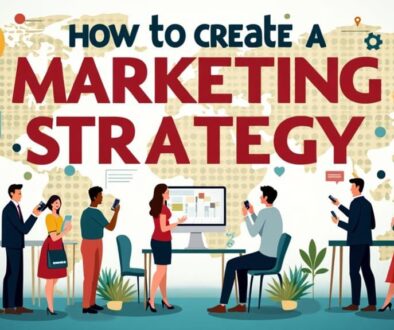How to Use Storytelling in Your Marketing Strategy
To effectively integrate storytelling into your marketing strategy, start by understanding your audience and their emotional needs. Develop core brand stories that reflect your values and resonate with consumers' aspirations. Create compelling narratives featuring relatable characters that illustrate your brand's mission. Utilize the right platforms to amplify your message, choosing those that foster engagement with your target demographic. Finally, measure the impact of your storytelling through metrics such as engagement rates and conversions. This approach not only builds loyalty but differentiates your brand in a competitive landscape, revealing deeper strategies worth exploring further.
Key Takeaways
- Understand your audience through segmentation to create tailored narratives that resonate emotionally.
- Identify core brand stories that reflect your brand values and customer experiences to build genuine connections.
- Develop compelling narratives by creating relatable characters and focusing on shared experiences rather than just products.
- Choose the right platforms for your storytelling to maximize reach and engagement with your target audience.
- Continuously measure storytelling impact with metrics like audience engagement and conversion rates to refine your strategy.
Understand Your Audience

Understanding your audience is essential to crafting compelling marketing stories that resonate deeply and drive engagement. By leveraging audience segmentation, you can tailor your narratives to meet distinct emotional needs and preferences, fostering a genuine connection that promotes loyalty and advocacy.
In today's fast-paced world, consumers crave more than just products; they seek stories that speak to their experiences and aspirations, ultimately giving them a sense of freedom in their choices.
Segmenting your audience allows you to identify distinct groups based on demographics, interests, and behaviors. This strategic approach enables you to create targeted messaging that resonates with each segment.
Consider how different groups may respond to various themes—one might value adventurous storytelling, while another seeks reassurance and stability—therefore, understanding these nuances is vital to establish an emotional connection.
The heart of effective storytelling lies in authenticity. Consumers are increasingly savvy and can discern insincerity. As you align your brand narrative with the values and desires of your audience, you encourage them to envision themselves within your story.
This synergy not only humanizes your brand but also enhances the overall experience, inviting audiences to engage more deeply. By honing in on your audience's unique characteristics and emotional triggers, you cultivate a message that inspires freedom of choice, encourages exploration, and ultimately strengthens customer affinity.
Embrace audience segmentation as a powerful tool to weave impactful, relatable stories that truly resonate.
Identify Core Brand Stories
A strong foundation of core brand stories is essential for creating a compelling narrative that resonates with your audience and differentiates your brand in a crowded marketplace. Identifying these stories involves a thorough exploration of your brand values and the experiences that your customers have with your offerings.
Begin by reflecting on what your brand stands for. What values guide your mission? These core values serve as the backbone of your storytelling, providing authenticity that customers can relate to. For instance, if sustainability is a key value, your brand stories could focus on eco-friendly practices, how they evolved, and the positive impact you've made on the planet.
Next, consider the customer experiences that illustrate these values. Highlight stories where clients have felt empowered, transformed, or even liberated by your products or services. A narrative that showcases real-life testimonials or challenges faced and conquered can empower potential customers to envision themselves within your brand's journey.
Furthermore, engage your team to brainstorm diverse perspectives on what your brand means to them. This collective insight can reveal hidden narratives that resonate deeply with audiences.
Ultimately, identifying core brand stories is not merely about brand promotion; it's about building connections based on shared values and meaningful experiences. By weaving these elements together, you craft narratives that not only tell who you are, but also invite your audience to participate, share, and spread the story further—a powerful invitation to the freedom your brand embodies.
Create Compelling Narratives

How can brands transform their core values into compelling narratives that captivate audiences? The answer lies in the art of storytelling, where strong character development acts as a bridge between a brand's mission and its audience's emotional landscape. By crafting relatable characters that embody the brand's values, companies can illustrate their beliefs in a manner that resonates deeply with consumers.
Think about the heroes in your stories. Are they pioneers of change, visionaries seeking freedom, or everyday individuals working for a greater purpose? Each character should evolve, facing challenges that highlight the brand's commitment and tenacity. As they navigate their journey, the emotional connections forged with the audience become powerful tools for engagement.
In a world intent on authentic interactions, storytelling offers a medium through which brands can express their essence. It's vital that narratives don't merely focus on products but instead center on experiences and shared values. This approach invites the audience to become part of the story, transforming passive viewers into enthusiastic brand advocates.
Ultimately, compelling narratives are about more than just conveying information; they're about inspiring connections. By cultivating emotional ties through strategic storytelling, brands empower consumers, fostering loyalty born from shared triumphs and ideals.
Engaging storytelling not only elevates marketing efforts but ignites a passion for and belief in the brand, ensuring that it occupies a treasured space in the hearts of its audience.
Choose the Right Platforms
Selecting the right platforms for storytelling amplifies the impact of a brand's narrative and extends its reach to the intended audience. In today's digital landscape, leveraging the appropriate channels for sharing your story is vital to engaging consumers who crave authentic connections.
Social media, with its vast and diverse user base, offers an unparalleled opportunity to disseminate your brand's narrative in real time, while fostering community engagement and dialogue. Platforms such as Instagram and TikTok emphasize visual storytelling, enabling brands to encapsulate narratives through compelling imagery and short videos. This style resonates particularly with younger audiences seeking relatable and entertaining content.
Conversely, platforms like LinkedIn cater to professional audiences, making them ideal for more sophisticated narratives aligned with industry insights and thought leadership.
Incorporating storytelling into your content marketing strategy means evaluating where your audience spends their time and what types of stories resonate with them. Engaging stories shared through well-chosen platforms not only enhance brand loyalty but also empower consumers, allowing them to connect on a deeper level with the values your brand represents.
Ultimately, the right combination of platforms can turn storytelling into a dynamic tool that transcends traditional marketing boundaries. By understanding which channels best suit your narrative, you elevate your brand's voice, ensuring it is heard loud and clear amidst the digital noise, fulfilling your audience's desire for connection and freedom of choice.
Measure Storytelling Impact

Measuring the impact of storytelling in marketing is essential for understanding its effectiveness and refining strategies. To truly harness the potential of narratives, brands must assess storytelling metrics that align with their goals. Metrics such as engagement rates, shares, and time spent on content can provide invaluable insights into how well a story resonates with the audience.
Audience engagement is a key driver in evaluating storytelling effectiveness. By analyzing comments, likes, and interactions across various platforms, businesses can discern not only what captivates their audience but also what compels them to act. The level of emotional connection established through storytelling often dictates the strength of engagement; consequently, gauging sentiment analysis is equally critical. This qualitative measure can reveal deeper insights into what customers genuinely feel about the brand.
Furthermore, tracking conversion rates linked to storytelling campaigns can illuminate the direct impact of narrative-driven content on the sales funnel. For example, observing increased sales following a powerful story about a product's origin or purpose showcases the potential of storytelling to convert casual listeners into loyal customers.
In a world where freedom of choice prevails, marketers must embrace the responsibility of evaluating their storytelling strategies. By continuously measuring storytelling impact, brands can pivot and adapt to the changing landscape, ensuring that their stories remain relevant and authentic, ultimately enriching the audience's journey.
This conscious approach leads to a more profound connection with the audience, enabling storytelling to flourish within the marketing environment.
Frequently Asked Questions
How Can Storytelling Enhance My Brand's Emotional Connection With Customers?
Storytelling greatly enhances a brand's emotional connection with customers by employing narrative techniques that resonate on a personal level.
By weaving authentic stories into marketing efforts, brands can foster deeper customer engagement and loyalty. This approach allows consumers to see reflections of their own experiences, creating relatable connections that promote a sense of community.
Ultimately, effective storytelling transforms brands from impersonal entities into relatable companions on the customer journey, enriching the overall experience.
What Are Common Storytelling Mistakes to Avoid in Marketing?
In the journey of crafting compelling narratives, brands often stumble upon common pitfalls. One frequent misstep is inconsistency in narrative, which can confuse audiences and weaken engagement.
Additionally, overlooking the audience's emotional triggers can dilute the story's impact. To cultivate a deep connection, guarantee your stories maintain narrative consistency while resonating with your audience's experiences.
Ultimately, a well-structured story fosters loyalty, serving as a powerful conduit to the freedom of authentic brand expression.
Can Storytelling Be Effective for B2B Marketing?
B2B storytelling can indeed be highly effective in cultivating relationships and driving engagement. By leveraging narrative impact, organizations can illustrate complex solutions in relatable terms, fostering an emotional connection with clients.
Effective B2B storytelling transcends traditional marketing by emphasizing shared values and experiences, ultimately promoting authenticity. When executed strategically, it not only enhances brand perception but also empowers decision-makers, guiding them toward informed choices that align with their business aspirations and needs.
How Long Should My Brand Stories Be for Different Platforms?
When considering story length, it is essential to acknowledge platform differences.
For engaging social media content, concise narratives (30-60 seconds) are most effective.
Blog posts can explore deeper, ranging from 500 to 1,500 words, allowing for rich storytelling that retains reader interest.
Video content should ideally be under two minutes to maintain viewer attention.
Tailor your story length to each platform to enhance engagement and resonance, empowering your audience through compelling narratives.
Are There Specific Visuals That Enhance Storytelling in Marketing?
In the domain of marketing, visuals hold the power akin to a painter breathing life into a blank canvas. Engaging visual storytelling utilizes striking imagery, colors, and videos to enhance narrative techniques, making your message resonate.
Infographics can distill complex information, while compelling photographs evoke emotions and connect with your audience. By integrating these elements strategically, your brand can transcend mere words, creating stories that inspire freedom and draw consumers into a shared journey.
Conclusion
Incorporating storytelling into marketing strategies cultivates deeper connections with audiences. By understanding the target demographic and identifying core brand narratives, organizations can create compelling, relatable stories that resonate. Selecting appropriate platforms for dissemination amplifies engagement, while the impact of storytelling must be measured to refine future efforts. As the adage goes, "The pen is mightier than the sword," illustrating that a well-crafted narrative can wield significant influence, effectively shaping perceptions and driving consumer behavior.




